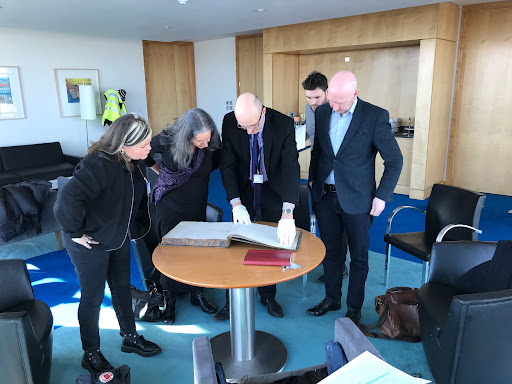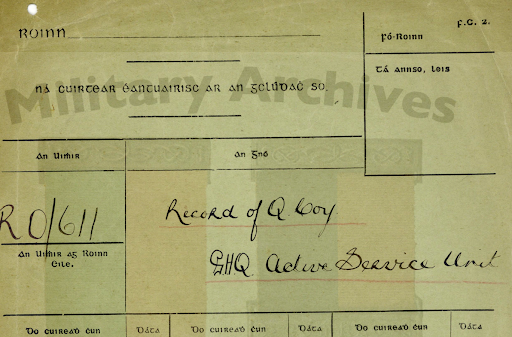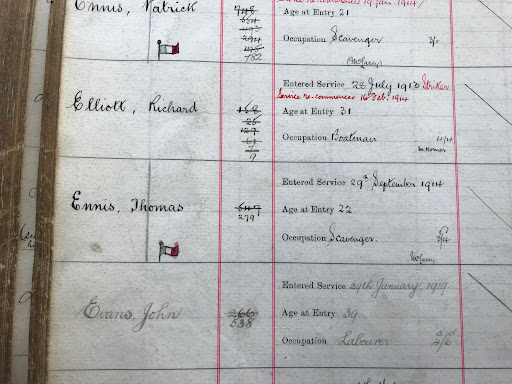DIRECTOR’S NOTE
By Louise Lowe | Writer and Director
Q Company was an active service unit of the IRA based in Dublin Port. Operating 24/7 in groups of six, they brought in 97% of all arms and ammunition needed for the War of Independence. The men were also responsible for the purchase, transport, shipping and handling of materials. This IRA Q company was in opposition to the other Q, the enemy Auxiliary Q company stationed at the nearby London and Northwestern hotel. Q on Q, each watching, surveilling and attacking the other in a deadly game of historical doublethink throughout 1921.
In February 2018 we commenced our exploration of the War of Independence in Dublin Port. Invited by heritage officers, Lar Joye and Jim Kelleher, we were joined onsite by acclaimed historians Pádraig Yeates and Catríona Crowe. Pádraig produced the first BOOK OF NAMES, an unpublished record book, listing the names of the men who were part of the republican movement and highlighting to us those who left en-masse to join free state forces. This unpublished record provided us with the framework and material to create an explosive work of historical detail that explores one of the most secretive, contentious and turbulent times in Irish history.
The second book of names, an intelligence record, was presented to us by Brenda Malone, Curator of Military History at the National Museum of Ireland in December 2018. This scrapbook was created by an IRA intelligence unit and was packed with photographs of members of the Auxiliaries and British intelligence agents living undercover in Dublin who are described in detail and marked for assassination. Other pages list photographs, names and personal details of civilians who are identified as potential informers and supporters of the cause.
The momentum of this project built throughout 2019. With support from the Arts Council, Landmark and ANU joined forces and invited actors, historians and designers to develop the work. We were delighted with ourselves, working onsite at the Port, we jumped into rigorous research. We discovered further moments of crossover and connections between the books. We met families of the men and others involved in the burning of the Custom House, and learned of our own affinities … my Great Aunt Sarah had been engaged to Edward Dorrins at the time of his death (the bracelet he is making within the show was a present for her) and my Great Uncle John Doran was one of the men who accompanied him into the Custom House. John was subsequently arrested and sentenced to imprisonment in Kilmainham. The propulsion of the work was thrilling – then COVID hit and both books were momentarily back on our shelves…
After a long hiatus, we returned to them and to making live theatre. In September this year, we were giddy to bring a full company of amazing performers, designers and makers back to the Pumphouse to finally build our show together. There was this sense of excitement, not just being back working, but of something else. For a myriad of reasons, the company fizzed, there was an alchemy in the rehearsal room … nobody served themselves because we understood these stories to be bigger than all of us and yet of us. In our play, one book supplies the other, classified information is smuggled alongside munitions, assassinations planned over bomb making, retaliations over ambushes. All are true events. I presented our cast with 20 names from our research on the first day of rehearsal and invited them to choose one person to focus on. The characters you meet are all summoned back to the Port by their respective performer, retracing their steps, actions and outcomes in a concentric loop. The audience splits at the you-you read and the show is performed by the full ensemble simultaneously across both sides. Each audience group is presented with a slightly different narrative and invited to become the dramaturgs of their own experience.
By exploring the War of Independence through the activity of Q company we created a lens through which the national struggle for emancipation is funnelled through the actions of those within. We filtered five critical episodes back into the Pumphouse: the Burning of the Custom House which saw the tragic death of Edward Dorrins; The Attack on the London and Northwestern Hotel; Jimmy Walsh and the bleeding statues of Templemore; and the aftermath of Bloody Sunday through the assassination of Shankers (John) Ryan. We created an overlapping kaleidoscope of events that shaped our nation, culminating *(spoiler alert ahead) in the final episode right before the outbreak of Civil War in which the Q company lawbreakers become lawmakers, leaving the port en-masse to form part of the new national army. Leaving them caught in this vicious moment, when friend turns on friend, we are asked “what do we do now”?
In theatre as much as war: “We Go Again”.
1. Looking through the original book of names (2018)
(L-R) Lynnette Moran, Catriona Crowe, Lar Joye, Matt Smyth and Jim Kelliher
2. Military Archive material for Q company (ASU)
3. Detail from the Port Book of Names featuring Tom Ennis (Q company) commanding officer.


